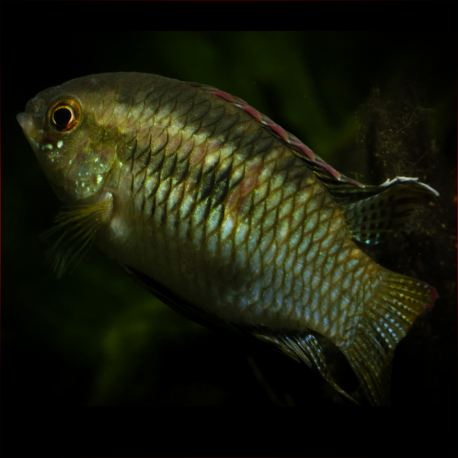More info
Datasheet
| Maximum Size | 5.0cm / 1.97inches |
| Temperature | 20°C / 68.00°F - 28°C / 82.40°F |
| Hardness | 1.01dgH / 18ppm - 15.02dgH / 268ppm |
| pH | 4.5-7.5 |
General Description
The Dwarf Flag Cichlid, scientifically known as Laetacara Curviceps, is a popular species within the Cichlidae family and is also referred to by various other common names such as 'flag acara,' 'smiling acara,' 'sheepshead acara,' and 'blunt-headed cichlid.' This small cichlid species measures up to 5.0cm in length and can be distinguished from other species in its genus by specific physical attributes, including the presence of a dark spot on the dorsal-fin base in males.
Aquarium Setup
Dwarf Flag Cichlids require an aquarium setup that replicates their natural habitat. They thrive in clear, transparent water with a low flow rate and minimal suspended sediment. The tank should include substrates like leaf litter and macrophytes such as Cabomba, Myriophylum, and Eichhornia spp. Water parameters should ideally be maintained at a hardness of 18-268ppm, pH range of 4.5-7.5, and a temperature between 20-28°C (see table for details).
Behaviour
As a species, Dwarf Flag Cichlids are known to be substrate-spawners and display biparental care when breeding. In an aquarium setting, they exhibit typical cichlid behavior, which can include territorialism, especially during the breeding season.
Feeding and Diet
In their natural habitat, Dwarf Flag Cichlids are foragers that feed on algae, organic detritus, insects, worms, crustaceans, and zooplankton. When kept in an aquarium, they readily accept a diet of small live and frozen foods like bloodworms, Daphnia, and Artemia, supplemented with high-quality dried flakes and granules that contain plant or algal content.
Reproduction & Dimorphism
During breeding, Dwarf Flag Cichlids engage in biparental care and are substrate spawners. Males can be differentiated by the presence of a dark spot on the dorsal-fin base. Breeding males and females may display red pigmentation on their cheeks, opercula, and belly, unlike non-breeding individuals.
Habitat and Distribution
Native to the lower Amazon river basin in Brazil, Dwarf Flag Cichlids are found in habitats like minor tributaries, oxbow pools, and marginal lakes with substrates consisting of leaf litter and various macrophytes. Populations in different regions may exhibit variations in color patterns, particularly in the extent of red and blue pigmentation on their bodies and fins.
Etymology
The genus name 'Laetacara' is derived from the Latin words 'laetus,' meaning 'happy,' and 'acará,' a term used for cichlids in parts of South America, alluding to the smiling appearance of members of this genus. The species name 'curviceps' originates from the Latin words 'curvus,' meaning 'bent' or 'curved,' and '-ceps,' meaning 'headed,' likely in reference to a specific physical characteristic.

